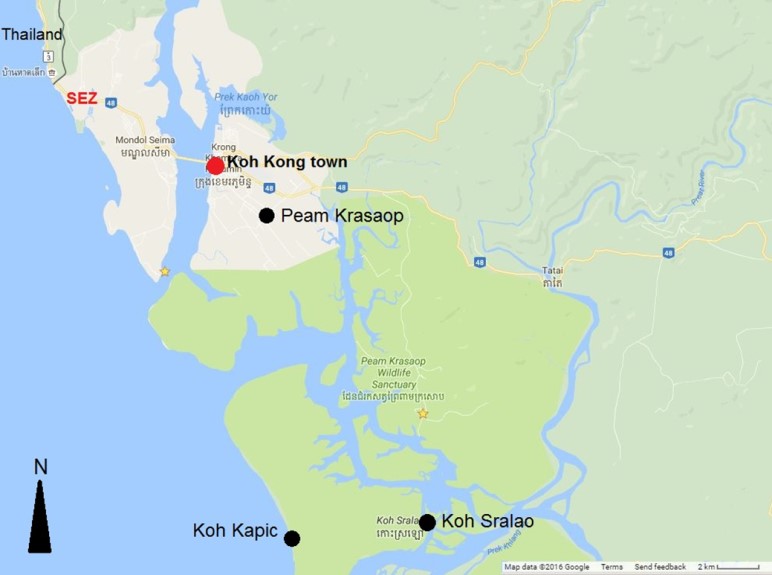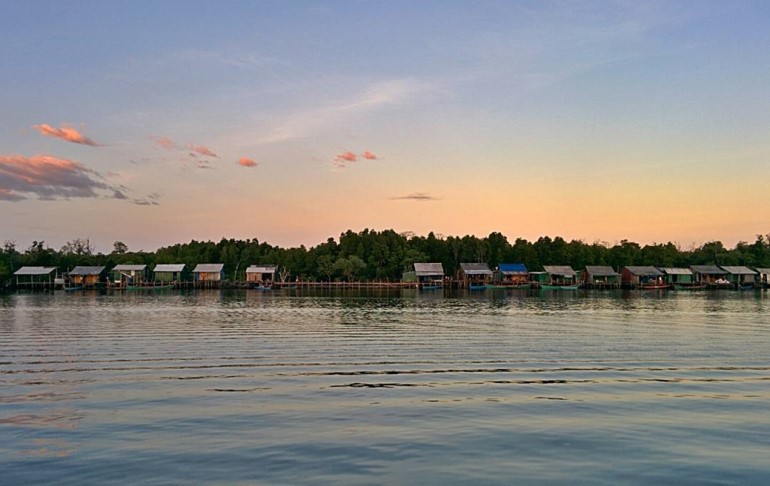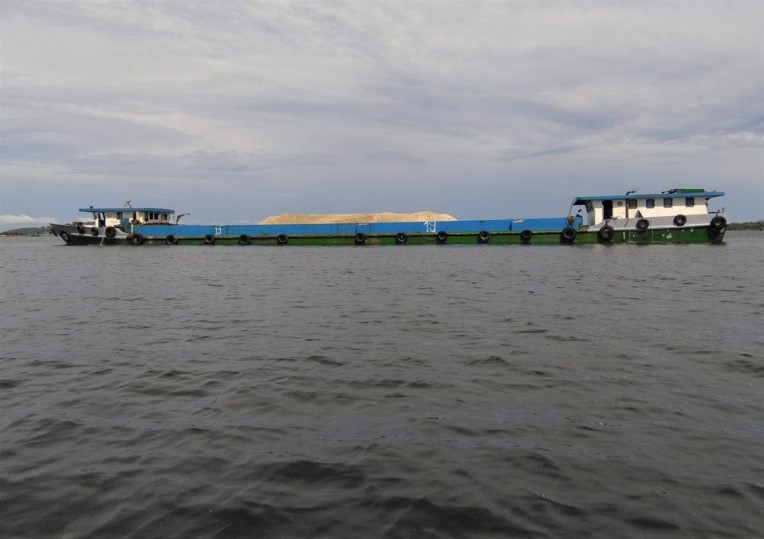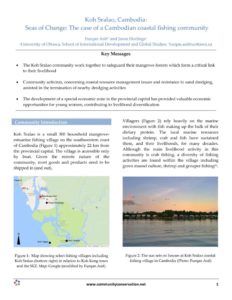
08 Jun Koh Sralao, Cambodia
Furqan Asifa* and Jason Horlingsa
aUniversity of Ottawa, School of International Development and Global Studies; *furqan.asif@uottawa.ca
Key Messages
- The Koh Sralao community work together to safeguard their mangrove forests which form a critical link to their livelihood
- Community activism, concerning coastal resource management issues and resistance to sand dredging, assisted in the termination of nearby dredging activities
- The development of a special economic zone in the provincial capital has provided valuable economic opportunities for young women, contributing to livelihood diversification
Community Introduction

Figure 1: Map showing select fishing villages including Koh Sralao (bottom right) in relation to Koh Kong town and the SEZ. Map: Google (modified by Furqan Asif).
Koh Sralao is a small 300 household mangrove-estuarine fishing village on the southwestern coast of Cambodia (Figure 1) approximately 22 km from the provincial capital. The village is accessible only by boat. Given the remote nature of the community, most goods and products need to be shipped in (and out).
Villagers (Figure 2) rely heavily on the marine environment with fish making up the bulk of their dietary protein. The local marine resources including shrimp, crab and fish have sustained them, and their livelihoods, for many decades. Although the main livelihood activity in this community is crab fishing, a diversity of fishing activities are found within the village including green mussel culture, shrimp and grouper fishing(1).
Local fishers use mechanized boats and gill nets or crab traps to harvest the marine resources in and around the mangrove estuarine area, or within a few kilometers of the coastline. Households work together, with men (sometimes with their wives) going out to fish daily or spending a few days on their boats and women sorting, processing and selling aquatic products to a handful of local traders (aquatic products typically go to the provincial town, and then may move to Cambodia’s capital or into Thailand).
However, sustaining a small-scale fisheries livelihood is challenging(2) and livelihoods have diversified within and beyond the village. For example, households may have family members working (temporarily or permanently) in construction or factory jobs. While this work has typically been in another province, in Cambodia’s capital or in Thailand, there are now wage-labour opportunities particularly for young women in the provincial capital at the Special Economic Zone (SEZ), near the border with Thailand.
Conservation and Livelihood Challenges
Declining Fish Populations

Figure 2: The sun sets on houses at Koh Sralao coastal fishing village in Cambodia (Photo: Furqan Asif)
Fishers have spoken about fish declines for decades(2) and continue to be concerned about fish stocks. The observations made by Koh Sralao fishers are consistent with statistics for the Gulf of Thailand which shows a dramatic decrease in catch per unit effort (an indirect measure of fish abundance) over the past decades.
The declines observed in Koh Sralao‘s aquatic resources may be due to a number of different factors. Fishers have observed an increase in foreign fishing vessels in the nearshore area. Thai fishing vessels may have moved into Cambodian waters as a result of Thailand’s fisheries reform(4). Fishers also talk about the impacts of climate change on aquatic resources. Although the direct effects of climate change on fisheries in Koh Sralao are not yet clear, it seems that rains are less predictable and storms may be more frequent. Additionally, ocean warming may be impacting fish migration routes and reproduction(5).
Sand Dredging
In addition to the persistent decline in catch, sand dredging, which began in the Koh Sralao area in late 2007, has had an impact on the aquatic resources surrounding the Koh Sralao community (Figure 3). The short term impacts of this dredging are clear(3):
- Fish habitat is being destroyed. Dredging deepens shallow channels, impacting fish and other aquatic habitat in the process
- Fish migration routes are being disturbed, and the water is said to be more turbid
- Boats have been dredging near the edge of the mangroves, partially damaging some trees and completely ripping out others
Community Initiative
Koh Sralao is a village with a history of community organization around resource management(2). This means that villagers have been able to organize formally but also use informal channels to express their concerns.

Figure 3. A barge carrying sand from sand mining operations in Koh Kong (Photo: Furqan Asif)
Sand Dredging
Villagers have been concerned about the sand dredging since it began (a decade ago), and have been involved in protests, public consultations and meetings with sand dredgers. At one point the sand dredging came within eyesight of Koh Sralao, which mobilized villagers yet again. The Koh Sralao community has received suport from NGOs, with a public anti-sand mining campaign initiated in the past year by an activist NGO.
Mangrove Conservation
The Koh Sralao community has worked together to safeguard their natural environment. They have become aware of the importance of conserving the mangrove forests that form a critical link to their livelihood. For example, annual mangrove replanting has become a community tradition since the late 1990s.
Livelihood Diversification
Households too have responded to marine resource degradation by shifting livelihood activities away from fisheries to factory wage-labour. It is predominantly the young women in Koh Sralao that go to work at the Koh Kong Special Economic Zone, since factories at the SEZ mainly hire women between the ages of 18 – 25. However, there is no maternity leave for women, and it is difficult for women to return to the SEZ after the age of 28. Thus, while young women are gaining more opportunities beyond the fishing village, such gains are time-sensitive and it is unclear how many young women may return to the village at another point in their lives.
Practical Outcomes
Sand Dredging
One of the outcomes of the initial protests to the sand dredging was that the dredging activities moved to another area, not within sight of Koh Sralao. However, the community wanted the activity to stop altogether because the negative impacts of the sand dredging continued to be felt, particularly in the crab fishery. Through support and training, provided to the villagers by a grassroots Cambodian NGO, along with the organization’s own media campaign, the concerns and rights of the Koh Sralao villagers continued to be voiced. In November 2016, the Ministry of Mines and Energy announced that they had halted sand dredging operations in Koh Kong(6).
While it remains to be seen whether the termination of sand dredging is permanent or temporary, it is certainly welcome news to the villagers and for the conservation of the mangrove ecosystem. More broadly, this story not only highlights the challenges of natural resource-based livelihoods and the pressures that coastal communities face (shaped by socioeconomic and political forces) but also the importance and impact of grassroots community activism for coastal ecological conservation.
Livelihood Diversification
Local factory labour opportunities continue to provide a higher, more consistent income than would otherwise be the case for most young women in Koh Sralao. Women are sending remittances home, and for these households this is an additional source of income (even if time sensitive), all the more important given the challenge of small-scale fisheries livelihoods. Moreover, women are able to stay in the local area, something both young women and their families appreciate.
References
- Marschke, M., “Exploring Rural Livelihoods Through the Lens of Coastal Fishers”, Handbook of Contemporary Cambodia, K. Brickell and S. Springer (Eds)., Routledge, 2017, pp. 101-110.
- Marschke, M. (2012). Life, Fish and Mangroves: Resource Governance in Coastal Cambodia. Retrieved from http://www.ruor.uottawa.ca/handle/10393/20676
- Marschke, M. (2014, June 12). Sand mining returns – dredging for every last grain within Cambodia’s coastal protected area. Retrieved May 10, 2017, from https://melissamarschke.wordpress.com/2014/06/12/sand-mining-returns-dredging-for-every-last-grain-within-a-coastal-protected-area/
- WorldFishing & Aquaculture. No more free rides – as Thailand reforms fisheries. 11 October 2016. Retrieved from http://www.worldfishing.net/news101/industry-news/no-more-free-rides-as-thailand-reforms-fisheries
- Savo, Valentina, Cedar Morton, and Dana Lepofsky. 2017. “Impacts of Climate Change for Coastal Fishers and Implications for Fisheries.” Fish and Fisheries.
- Narim, K., & Paviour, B. (2016, November 17). Sand Extraction in Koh Kong Province Halted, Ministry Says. The Cambodia Daily. Retrieved from https://www.cambodiadaily.com/news/sand-extraction-koh-kong-province-halted-ministry-says-120637/
Acknowledgements
This work was supported by funding from the Social Science and Humanities Research Council and the Urban Climate Resilience in Southeast Asia (UCRSEA) project. The authors would like to acknowledge the support and mentorship of Dr. Melissa Marschke, along with her valuable input and comments in the drafting of this story.
Correspondence:

![]()
![]()
Community Conservation Research Network
Saint Mary’s University
Halifax, Nova Scotia
B3H 3C3 Canada
Phone: 902.420.5003
E-mail: ccrn@smu.ca



